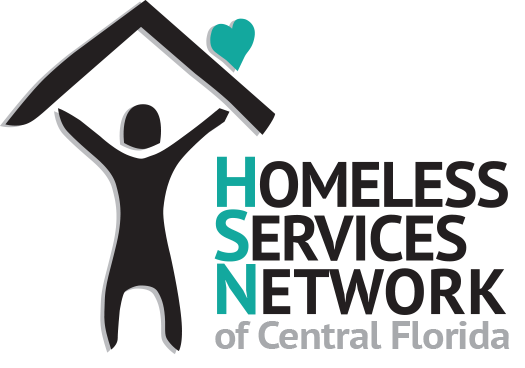
WELCOME HOME
Our Impact
We work to provide stable, long-term housing to people experiencing homelessness. Our primary focus is on veterans, youth, people with disabilities, victims of domestic violence and human trafficking, and families with minor children.In 2024, we helped 5,132 people who were homeless return to stable, safe, long-term housing. But on any given night, there are still more than 1,000 people in Orange, Osceola and Seminole counties who have no choice but to sleep on our streets, in their cars, or in the woods. Our region's emergency shelters are routinely full, and the average two-bedroom apartment (at $2,206 a month) is beyond their reach, even though many of them are working. Over 40% of this unsheltered population is made up of children and people age 55 and older. The fastest growing population?Women 65 and older.With your support, we can help them.
Our Vision
The Homeless Services Network of Central Florida is committed to the belief that everyone needs a safe place to call home.
Our mission is to lead Central Florida’s community-wide effort to help make any experience of homelessness rare and brief. We work with dedicated frontline partners — including nonprofit outreach staff, the Department of Veterans Affairs, local shelters, case managers, housing advocates, health-care providers, domestic violence agencies and human trafficking recovery programs. We help raise critical funds for housing, we recruit private landlords and property owners, we pay the rents, we advocate for housing justice, and we staff the locations where people can apply for help and meet with a caring intake worker to address their needs.
Become an advocate for affordable housing and shelter!
Despite an estimated shortage of 97,649 housing units for our lowest wage-earners, virtually every attempt to create more affordable housing or homeless shelters has been met with neighborhood protests. Yet small, innovative housing and shelter solutions — located throughout the region — are the only realistic way to address the dire need. Please join our growing campaign to show you may be willing to have affordable housing and shelter located in your neighborhood — or that, at the least, you’re willing to learn more. Click below to join the conversation!
Thank you to the 300+ volunteers who joined the
2025 Point-In-Time Count
On Jan. 28th, 29th or 30th, more than 300 volunteers joined us for the 2025 Point-in-Time Count — our annual “census” of Central Floridians who are homeless. The count takes place in communities across the nation at least once every two years, and the data is critical to understanding the scope and trends of homelessness. Most importantly, it helps to guide our local leaders as they make policy and funding decisions.
The data is first reviewed to check our methodology and ensure that everyone surveyed is only counted once, after which it will be made public. Stay tuned…
(See data from the 2024 Point-in-Time Count here.)

Youth homelessness
Brighter Days Central Florida, our community initiative to prevent and end homelessness among older teens and young adults, means connecting people ages 16-24 both to housing and the opportunities they need to change the trajectory of their lives. Help can include rental assistance, host homes, diversion support, navigation guides, case workers, and connection to health care, job training and educational programs. To learn more or get involved, click here.
Supreme Court ruling compounds tragedy of homelessness
On June 28, 2024, the U.S. Supreme Court ruled that cities can ban people from sleeping and otherwise surviving in public spaces, even when there is no alternative. This ruling opened the door to arresting people experiencing homelessness because they have nowhere else to go.
Worse, it came as Florida implemented the “Unauthorized Public Camping and Public Sleeping” passed by the Legislature, which subjects counties to lawsuits if they “allow” public sleeping rather than establishing state-sanctioned camps where everyone who is unsheltered must live. This is both dangerous and wasteful of taxpayer money, and it does nothing to resolve homelessness.
For the full statement on the impact of this ruling and this law, click here.
Make an impact!
There’s no greater gift than helping someone have a safe place to call home.
Housing AND Services
The term Housing First has been largely mischaracterized as a housing free-for-all, as if people merely could refuse to get a job, sit on a sidewalk, and qualify for a free apartment.
This has never been the way things worked here.
“Housing First” was initiated as a homeless-assistance approach that prioritized getting people into low-cost, stable housing without requiring that they first go through job training, engage in mandatory religious programs, or immediately overcome whatever addictions or mental health conditions they were battling. It has been a recognition that emergency shelters are often already at capacity and that living on the streets is traumatic, dangerous, and deprives people of healthy sleep, proper nutrition and even adequate hydration.
And no community in America wants more people living on its streets.
We believe in providing a safe place where people can recover, address their challenges, and work with case managers to access a variety of services, opportunities and education. While about 20% of people experiencing homelessness have chronic disabling conditions — including those with cancer, heart disease and serious mental illness — the remaining 80% work to increase their income and become self-sustaining.
Overwhelming evidence has found that this approach is successful in helping people to remain housed and is actually cheaper than alternatives. So why do critics say it doesn’t work? Because, in recent years, the number of people becoming homeless for the first time has skyrocketed with the growing unaffordability of housing. People are flooding into the system far faster than they can be airlifted out.
Read more about what is better described as a housing-focused approach here.
Homelessness Facts
Between July 1, 2023, and June 30, 2024, nearly 14,600 people sought help from our network, either because they were worried about becoming homeless, or because they were already experiencing homelessness.
Of those:
3,438 were children
1,217 were survivors of domestic violence
1,972 were veterans
1,806 were people with disabilities who had already spent more than a year unhoused.
1,140 were age 62 or older
4,370 had no health insurance
Support for Landlords & Advocates
We need landlords and property managers to work with us in order to fulfill our mission. You are an essential part of the process -- and you can do good while still earning a return on your investment.
Thank you for an amazing celebration of our 30th anniversary!
We raised much-needed funds for housing, shared some poignant stories, heard from one of the nation’s thought-leaders on homelessness, and named the inaugural recipient of our Thomas C. Chatmon Jr. Community Champion Award…
Click below to find out who won and to see all the photos — plus a special thank-you to our host and our sponsors. We couldn’t have done it without you!











